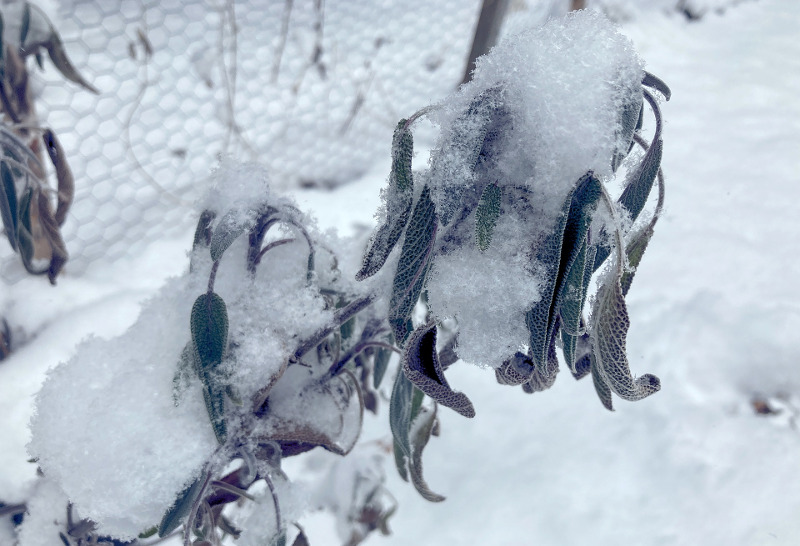Salvia plants come in a vast variety between cold hardy and heat loving. First, you must find out what growing zone you are in and what varieties you wish to plant with your garden or have on your patio. Anything above your growing zone will need to be brought inside or insulated to ensure its survival. For example, Rockin’ Blue Suede Shoes Salvia is considered an annual in zones below 9. So you’ve got yourself a variety of salvia that won’t survive during your winters. What now? You’ve got a couple of options.
If your salvia is planted within the ground, transfer it to a location near your home where there is lots of sunlight throughout the day. Then when the ground begins to freeze, you will need to add a thick layer of wood mulch to help insulate the roots.
What if you have salvia planted within containers outdoors and you do not want to bring them indoors? Check the thickness of the container your salvia is in. Is it thin and plastic based? Then you’ll need to either surround the entire pot with wood mulch or transfer your salvia to a thick pot or container.
If you wish to bring in your salvia, you will need to keep the pots in partial sun and keep the soil moist without overwatering them. Typically watering salvia indoors, during the wintertime, can be done once every 2-3 weeks.

Protecting Salvia in Winter
If you have salvia planted within the ground of your landscape and it is at or below your growing zone, the maintenance needed is minimal! For extra measures, add some wood mulch to further protect the roots during frosts and freezes.
If your salvia is either rated for growing zones above your zone or you’re growing saliva in a thin pot or container, extra precautions must be made. You may choose to either bring in your salvia to your indoor space or transplant your salvia to a sunny, protected area and insulate using wood mulch.
Cutting Back Salvia For Winter
Salvia doesn't need to be cut back except as necessary when older growth has shriveled up. The end of fall is a great time to prune your salvia to remove any of the older growth.
Salvia Winter Care in Pots
If the salvia you choose is considered hardy in your zone and you have it outdoors to overwinter, ensure that the pot or container it resides in offers plenty of insulation from freezing air. Thin plastic pots will cause the roots to be exposed to the cold and potentially cause the plant to die. To remedy this, transplant your salvia in a thick-walled pot or plant within the ground in a protected area near your home. Adding wood mulch around the root base of the salvia will provide ample insulation to protect your salvia’s roots.
Watering Salvia in Winter
With salvia, the need for water goes down dramatically when planted outdoors in the ground. There is the potential that you may not need to water any of your salvias over the winter season! If you notice that rainfall has been minimal, it does not hurt to check the root base for dry, cracking soil.
If you have your salvia planted in a pot or container, especially if it is located where rainfall cannot reach, then you’ll want to check your plant every 1-2 weeks to ensure it has enough moisture. Do not worry about a bit of dry soil every once in a while as wintertime is not a season of high water usage for your salvia.

Growing Salvia Indoors
If the salvia you have is meant for growing zones above your own, you will definitely want to bring it indoors. Salvia does not require direct sunlight and will do fine in a dimly lit garage or in a corner of your home that receives indirect sunlight. Monitor the watering needs every 1-2 weeks to make sure your salvia gets a small drink of water to sustain its chlorophyll production.
If you decide to transfer your salvia back outdoors once the last frost passes, harden off your salvia by placing it in an area that receives indirect sunlight for 6-8 hours a day. Continue doing this for 5-7 days and then place it in your desired location. Monitor your salvia for bright yellow or shriveled leaves if placed in full sun. If this happens, place it in a location with partial sun until it becomes acclimated to the sunlight.
Steps To Care For Salvia in Winter
Salvia is a great plant to have in your landscape or within your home, whether you choose a perennial or annual variety. Annual varieties need more maintenance, however they are quite resilient when it comes to watering needs. Because there is a massive number of varieties of salvia, it is best to look specifically at the individual variety care instructions.
Step 1 - Determine the hardiness of your selected varieties of salvia.
Step 2 - Choose a location to overwinter your salvia plants.
Whether in-ground or in a pot, location depends on the hardiness of your growing zone.
Step 3 - Indoor planting and outdoor potted salvia – water as needed.
Check in every 1-2 weeks on your salvia plants indoors or potted outside (that may not receive regular rainfall) and water without submerging.
Step 4 - Pruning is not necessary, but…winter is a great time to prune off older growth that is not prolific.
 |
Author Chris Link - Published 03-07-2022 |
